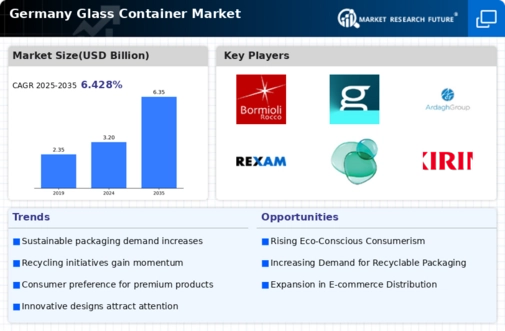Growth of the Beverage Industry
The growth of the beverage industry in Germany is a significant driver for the glass container market. With a rising preference for bottled beverages, including craft beers, juices, and soft drinks, the demand for glass containers is expected to increase. In 2025, the beverage sector is projected to contribute approximately 40% of the total demand for glass containers in the country. This trend is further supported by the perception of glass as a premium packaging material that preserves product quality and taste. As beverage manufacturers continue to invest in glass packaging, the glass container market is likely to experience robust growth. The interplay between consumer preferences and industry dynamics suggests a promising outlook for glass containers in the beverage sector.
Consumer Preference for Health and Safety
Consumer preference for health and safety is increasingly influencing the glass container market in Germany. As awareness of food safety and health concerns rises, many consumers are opting for glass containers over plastic due to the absence of harmful chemicals such as BPA. This trend is particularly evident in the food and beverage sectors, where glass is perceived as a safer option for packaging. In 2025, it is estimated that around 60% of consumers will choose glass containers for their perceived health benefits. The glass container market must capitalize on this trend by emphasizing the safety and purity of glass packaging. This focus on health and safety could potentially lead to a significant increase in market share for glass containers, as consumers prioritize their well-being.
Technological Advancements in Manufacturing
Technological advancements in manufacturing processes are significantly influencing the glass container market in Germany. Innovations such as automated production lines and energy-efficient melting technologies are enhancing production efficiency and reducing costs. In 2025, the market is projected to witness a 15% increase in production capacity due to these advancements. Furthermore, the introduction of smart glass technologies, which allow for customization and improved functionality, is likely to attract new customers. As manufacturers invest in modernizing their facilities, the glass container market is expected to benefit from increased competitiveness and the ability to meet diverse consumer needs. This technological evolution may also lead to enhanced product quality and reduced waste, further solidifying the market's position.
Regulatory Support for Sustainable Packaging
Regulatory support for sustainable packaging initiatives is shaping the glass container market in Germany. The government has implemented various policies aimed at reducing plastic waste and promoting recyclable materials. These regulations encourage manufacturers to adopt glass as a preferred packaging option, thereby enhancing the market's growth potential. In 2025, it is anticipated that compliance with these regulations will drive a 20% increase in the use of glass containers across various sectors. The glass container market must remain vigilant in adapting to these regulatory changes, ensuring that products meet the required standards. This supportive regulatory environment not only fosters innovation but also positions glass containers as a viable solution for businesses seeking to align with sustainability goals.
Rising Consumer Demand for Eco-Friendly Products
The glass container market in Germany experiences a notable surge in consumer demand for eco-friendly products. This trend is driven by an increasing awareness of environmental issues and a preference for sustainable packaging solutions. Consumers are gravitating towards glass containers due to their recyclability and lower environmental impact compared to plastic alternatives. In 2025, it is estimated that approximately 70% of consumers in Germany prioritize eco-friendly packaging when making purchasing decisions. This shift in consumer behavior is likely to propel the growth of the glass container market, as manufacturers adapt to meet these evolving preferences. The glass container market must innovate and promote the environmental benefits of glass to capture this growing segment of eco-conscious consumers.


















Leave a Comment